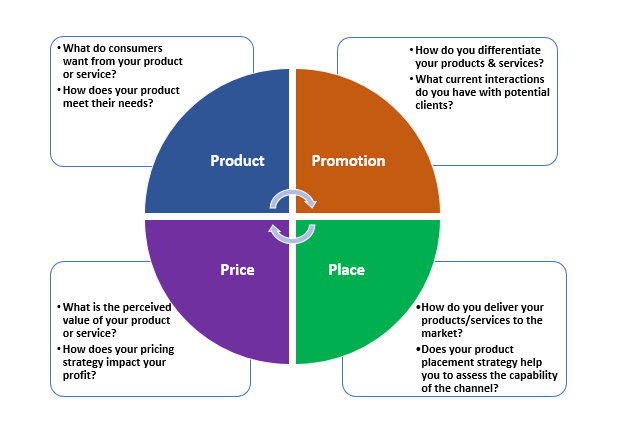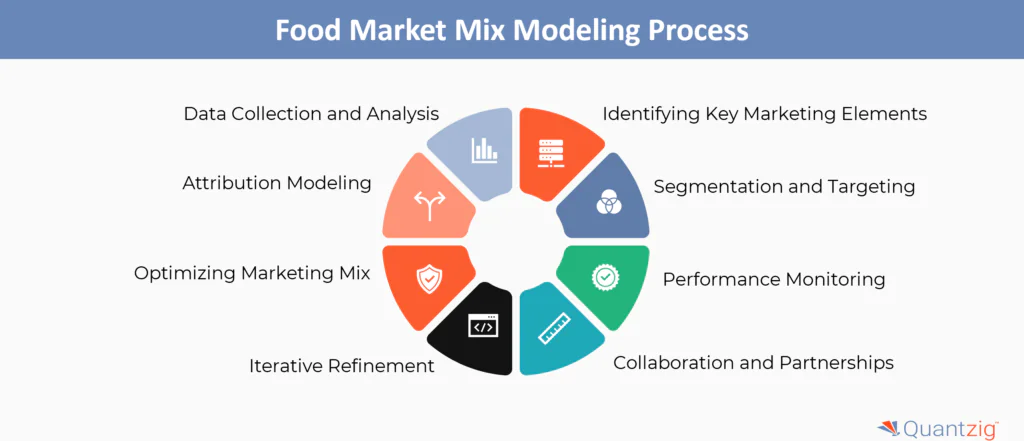Table of Contents
Table of Contents
- Introduction to Food Marketing Strategies
- What is Food Marketing?
- Why is Food Marketing Important?
- Four Ps of Marketing
- How Does Food Market Mix Modeling Work?
- Quantzig’s Expertise in Food Marketing Analytics Solution
- Conclusion
Author: Associate Vice President, Analytics and Data Strategy, Quantzig.
Introduction to Food Marketing Strategies
As a marketing leader in the highly competitive food and beverage industry, implementing an effective marketing strategy is crucial for driving brand awareness, boosting revenue, and gaining market share. Successful food marketing goes beyond catchy logos and advertisements – it requires a deep understanding of consumer psychology, industry trends, and innovative tactics to reach target audiences.
By partnering with a specialized team like Quantzig, food and beverage brands can develop a comprehensive marketing plan that leverages the latest strategies and best practices to elevate their presence, build customer loyalty, and stay ahead of the competition. With the right marketing approach, food and beverage businesses can create a lasting impact and achieve sustainable growth in this dynamic industry.
Book a demo to experience the meaningful insights we derive from data through our analytical tools and platform capabilities. Schedule a demo today!
Request a Free DemoWhat is Food Marketing?
Food marketing is the strategic process of promoting and selling food products and services to consumers. It involves the use of various marketing techniques, such as advertising, branding, and product placement, to influence consumer behavior, increase brand awareness, and drive sales within the competitive food industry. Effective food marketing requires a deep understanding of consumer preferences, market trends, and innovative marketing strategies to effectively communicate the unique value propositions of food offerings and build long-term brand loyalty.
Why is Food Marketing Important?
| Reason | Explanation |
|---|---|
| Building Brand Awareness and Customer Loyalty | Food marketing helps businesses create brand awareness and customer loyalty by communicating the value of their products and services effectively. |
| Influencing Consumer Choices | Food marketing plays a significant role in influencing consumer choices by creating ties of confidence and loyalty between producers/sellers and consumers. |
| Promoting Healthy Consumption | Food marketing can promote healthy consumption by highlighting the nutritional benefits of certain products and avoiding unhealthy marketing practices that contribute to childhood obesity. |
| Creating Emotional Connections | Food marketing can create emotional connections with consumers by using storytelling and emotional appeals in advertising, which can increase brand recognition and loyalty. |
| Building Relationships with Suppliers and Partners | Food marketing helps build relationships with suppliers and partners by ensuring access to the best ingredients and products, which is crucial for businesses that rely on seasonal ingredients or have limited supplies. |
| Increasing Sales and Revenue | Food marketing strategies, such as targeted campaigns and special offers, can increase sales and revenue by attracting new customers and encouraging repeat business. |
| Understanding Consumer Preferences | Food marketing involves understanding consumer preferences, demographics, and values to tailor marketing strategies effectively. |
| Effective Brand Positioning | Food marketing helps brands position themselves effectively in the market by highlighting unique selling points and creating a strong brand identity. |
| Digital Marketing Strategies | Food marketing heavily relies on digital marketing strategies, such as social media and online advertising, to reach a large audience and build relationships with customers. |
| Addressing Market Challenges | Food marketing helps address market challenges such as childhood obesity by promoting healthy food options and avoiding unhealthy marketing practices. |
Four Ps of Marketing


How Does Food Market Mix Modeling Work?

Food Market Mix Modeling is a data-driven approach that combines various strategies to optimize and enhance overall business performance in the food industry. This comprehensive methodology takes into account a multitude of factors, utilizing both traditional and digital marketing elements. Here’s a breakdown of how Food Market Mix Modeling operates:
1. Data Collection and Analysis:
Quantitative and qualitative data are collected from diverse sources, including sales figures, customer feedback, and market trends. In-depth analysis is conducted to identify patterns, correlations, and key insights related to the effectiveness of different strategies.
2 Identifying Key Marketing Elements:
Elements such as social media campaigns, advertising, blog and website content, print advertising, brand positioning, product packaging, and digital marketing content are evaluated for their individual impact on the business.
3. Attribution Modeling:
Attribution models are applied to determine the contribution of each marketing channel to sales and brand visibility. This helps in understanding the customer journey and touchpoints.
4. Segmentation and Targeting:
The target audience and market segments are identified based on demographics, preferences, and behaviors. This information is crucial for tailoring strategies to specific consumer groups.
5. Optimizing Marketing Mix:
With insights from data analysis, the marketing mix modeling is adjusted to maximize impact. This may involve reallocating budgets, refining messaging, or focusing on specific platforms and channels.
6. Performance Monitoring:
The effectiveness of strategies is continuously monitored through key performance indicators (KPIs) such as conversion rates, customer engagement, and brand visibility.
7. Iterative Refinement:
Food Market Mix Modeling is an iterative process. Regular evaluations and refinements are made based on changing market dynamics, consumer behavior, and the performance of different elements.
8. Collaboration and Partnerships:
Partnering with other brands, influencers, and stakeholders is integrated into the model to enhance credibility, reach a broader audience, and create synergies within the food industry ecosystem.
By employing Food Market Mix Modeling, businesses in the food industry can strategically allocate resources, refine their messaging, and create a holistic approach that aligns with the ever-evolving dynamics of the market. This data-driven strategy ensures that efforts are not only effective but also adaptable to changing consumer preferences and market trends.
Also Read: Track Business Progress with Marketing Analytics Dashboard
Experience the advantages firsthand by testing a customized complimentary pilot designed to address your specific requirements. Pilot studies are non-committal in nature.
Request a Free PilotQuantzig’s Expertise in Food Marketing Analytics Solution for a Leading US-Based Food Products Manufacturer
| Category | Details |
|---|---|
| Client Details | The client, a leading food products manufacturer, headquartered in the USA |
| Challenges Faced by The Client | – Client wanted to implement a food market mix function to enhance their offerings – Shift to digital platforms and multiple customer touchpoints made it challenging to analyze decision-making patterns – Faced challenge of allocating fixed budget across advertising channels – Client’s data was unstructured and scattered, making it difficult to analyze |
| Solutions Offered by Quantzig | – Quantzig adopted a comprehensive approach using marketing analytics – Gauged the contribution of each marketing vehicle to identify growth drivers – Helped client identify gaps, new product potentials, and reallocate budget |
| Impact Delivered | – Resulted in 35% increase in sales and 60% improvement in efficiency – Helped client drive campaign effectiveness, balance short-term and long-term strategies, quantify ROI, and optimize future investments |
How Can Quantzig’s Food Marketing Strategies Help?
| Service | Description |
|---|---|
| Tailored Strategies | Quantzig drives profitable growth with customized techniques for the food industry. |
| Creatives On Call | Experienced creatives ensure engaging marketing collateral and compelling online presence. |
| Brand Positioning & Revamping | Strategic brand positioning and image revamping for food manufacturers, grocers, restaurants, and hospitality. |
| Digital Marketing & SEO | Expertise in digital marketing, SEO, and Google Maps profile optimization to attract organic traffic. |
| Collaboration & USP | Partnering with other brands to amplify reach and highlight unique selling points for strong brand identity. |
| Influencer Marketing & Credibility | Leveraging influencers to enhance brand credibility and connect with the ideal audience. |
| In-Store Promotions | Designing targeted campaigns for in-store promotions and product demonstrations to captivate customers. |
| Social Media Marketing | Creating visually appealing content for Instagram, Facebook, and Twitter to ensure maximum visibility. |
Our food marketing strategies are not just about driving short-term sales; they are crafted to build lasting brand loyalty. By aligning with your brand message, values, and target audience, we propel your business towards sustained success in the dynamic food industry.
Also Read: Maximizing Marketing Budgets with Campaign ROI Analysis
Get started with your complimentary trial today and delve into our platform without any obligations. Explore our wide range of customized, consumption driven analytical solutions services built across the analytical maturity levels.
Start your Free Trial TodayConclusion
In conclusion, success in the food industry hinges on a well-executed strategy that encompasses various facets of the marketing mix. From social media campaigns and advertising to packaging design and brand positioning, each element plays a vital role in establishing a strong market presence. By adopting a holistic approach, leveraging digital channels, collaborating with other brands, and emphasizing unique selling points, businesses can not only drive profitable growth but also build lasting relationships with customers. The key lies in staying agile, adapting to market trends, and continually refining strategies to meet the ever-evolving needs of the target audience.




